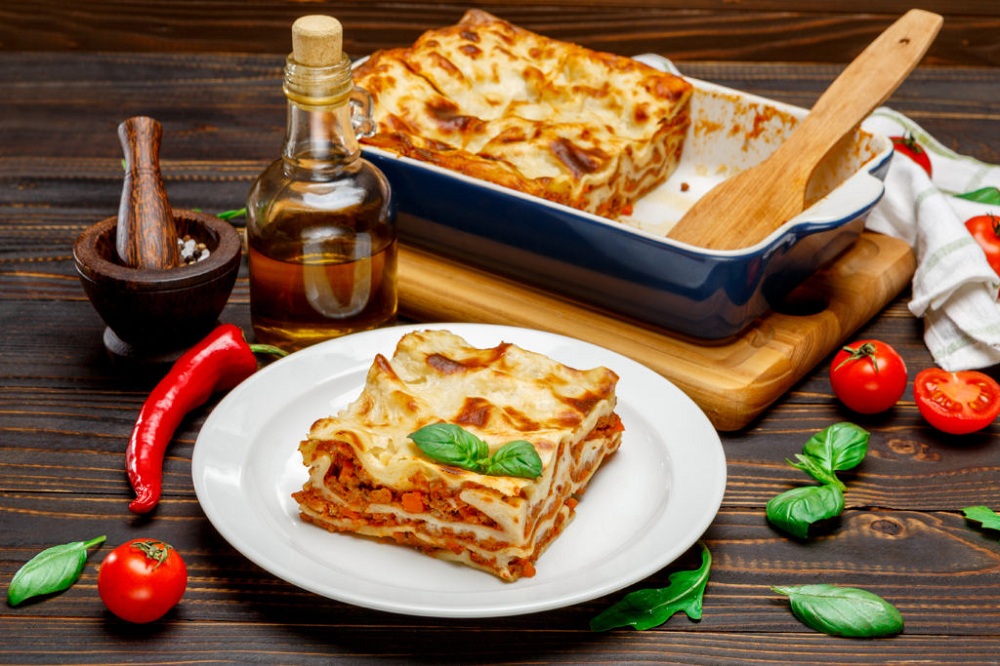Some call it a “pasta cake” to express their love for it: Lasagna is undoubtedly one of the most versatile dishes of Italian cuisine: Its filling of meat, vegetables or even fish, make it an excellent choice for main courses and it is loved by both grandmothers and millennials alike, who make it one of instagram’s most used hashtags and love sharing it with their friends, it’s always an option: at dinner with your friends or as lunch to take to work. Lasagna is for sure a dish that pleases everyone and probably because of it is it so popular they have even dedicated a day. Did you know that July 29 is World Lasagna Day?
With a history of several centuries, the origin of lasagna is actually the origin of different types of lasagne that blend together in the sources.
The term lasagna comes from the Greek “lasanon”, which in turn comes from the Latin “lasanum”, which referred to the container where this type of pasta was cooked in sheets.
The origin of lasagna dates back to the 1st century A.D. and it was Apicio, a Roman gourmet and supposed author of the Latin recipe book “De re coquianaria”, who first referred to the lasagna recipe, although it was not exactly as we know it now.
He described a dish consisting of thin sheets of pasta, stuffed with meat and cooked in the oven that he called “lagana”.
The Roman philosopher Cicero already started mentioning his passion for “Lagum”, a dish very similar to lasagna made from long strips of pasta in his cronycle and in the Middle Ages numerous writers continued referring to lasagna in their works.
However, everything seems to indicate that the origin of lasagna as we know it today dates back to 1316.
When the English awarded the dish in a London newspaper, indicating that the first documented mention of lasagna was in a 1390 recipe book dedicated to the monarch Richard II, the Italian authorities provided evidence that the authentic creator of lasagna was Maria Borgogno, who in 1316 already prepared her own recipe, very similar to the one we know today.
Lasagna, originally, included alternating layers of pasta and cheese, as Francesco Zambrini described it in the “Libro di Cucina” in 1863. The original recipe was enriched with the inclusion of tomato in the popular gastronomic culture. In fact, the first recipe for lasagna with tomato dates from 1881, which appeared in the book “Principe dei Cuochi or the Cucina Vera Napoletana”, by Francesco Palma.
Some Lasagna Recipes:
Lasagne Alla Bolognese
Named after the Italian capital of the Emilia-Romagna region, Among all the types of Italian lasagna that exist, one of the best known in the world is undoubtedly the lasagne alla Bolognese.
This dish made with pasta slices includes layers of béchamel sauce and Bolognese sauce, also known as ragú, which is made with minced beef and pork, carrots, celery, onions, tomatoes and salt. Grated Parmesan cheese is added on top to get that delicious gratin.
Neapolitan Lasagna
More common in the south of Italy, it is a typical carnival dish that is prepared with slices of lasagna, mozzarella, scamorza, tomato sauce, eggs, meatballs, ricotta and Neapolitan ragout, a sauce similar to the Bolognese sauce that is made with beef and other types of pieces. of meat, ham and sausage mixed with carrot, celery and tomato sauce, seasoned with pepper and marjoram leaves.
Lasagna with Pesto
This lasagna is less known, but just as delicious. Lasagna with pesto, also called Lasagna of Portofino, is typical of the Liguria region. In this case, the pasta sheets are interspersed with the Genoese pesto, whose characteristic flavor comes from basil and pine nuts.
Which Lasagne to Buy
Lasagna sheets are available in virtually all supermarkets in different variations: flat or with curvy borders, of durum wheat semolina flur, with added egg, spinach or in innovative recipes of einkorn, spelt, gluten-free, there’s for every taste.
The country of origin of most lasagne sheet production is, unsurprisingly, Italy, as confirms the staff of Pastificio Rigo, a leading manufacturer of lasagne based in the country’s northeast and producing for the most renowned pasta brands worldwide: “As for all dried pasta products, the parameter the check is the length of the drying process, at least 6 hours at temperatures as low as possible will yield the best taste”. Traditional Italian pasta used to be dired for as long as 50 hour under the sunlight, at 33 degrees, but the needs of modern consumer business would not match such long times.
Did you know?
The different types of Italian lasagna have crossed national borders to sneak into world cuisine, so much so that every July 29, World Lasagna Day is celebrated in honor of this dish.
But not only that, lasagna has also exceeded the earth’s boundary!
In 2013, chef Davide Scabin prepared a Bolognese lasagna for the International Space Station. Baptized as the “space lasagna,” each serving lasts 36 months and supports the dehydration and hydration process without losing its flavor.
And, although it has been a long time since the origin of lasagna, this dish still evokes that pleasant feeling of being at home, isn’t it?

